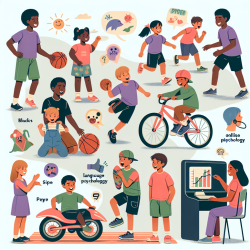Unlocking the Potential of Youth Well-Being: A Data-Driven Approach
In the field of speech-language pathology and education, the well-being of children and adolescents is a paramount concern. A recent study, "Putting Youth on the Map: A Pilot Instrument for Assessing Youth Well-Being," offers a groundbreaking approach to understanding and enhancing youth well-being through a geo-referenced index. This blog post will delve into the study's findings and explore how practitioners can leverage these insights to improve outcomes for children.
The Shift from Negative to Positive Indicators
Traditionally, measures of youth well-being have focused on negative indicators, such as dropout rates or substance abuse. However, this study emphasizes the importance of positive indicators, such as physical health, educational achievement, and supportive social relationships. By shifting the focus to positive factors, practitioners can foster environments that promote growth and resilience among youth.
Localized Data for Targeted Interventions
One of the study's key innovations is its use of a sub-county geographic scale, allowing for detailed analysis at the school district level. This localized approach provides valuable insights into geographic disparities in well-being, enabling targeted interventions that address specific community needs. For example, a district with low scores in physical fitness might benefit from programs that encourage physical activity and healthy lifestyle choices.
Integrating Subjective and Objective Measures
The study combines subjective measures, such as self-reported life satisfaction, with objective data from sources like the U.S. Census Bureau and the California Department of Education. This comprehensive approach ensures a holistic understanding of youth well-being, capturing both the lived experiences of youth and the structural factors that influence their development.
Practical Applications for Practitioners
Practitioners can use the insights from this study to inform their practice in several ways:
- Data-Driven Decision Making: Utilize the geo-referenced index to identify areas of need and tailor interventions accordingly.
- Focus on Positive Indicators: Shift the emphasis from problem prevention to the promotion of protective factors and positive development.
- Collaborative Efforts: Engage with local stakeholders, including schools and community organizations, to implement comprehensive strategies that address multiple domains of well-being.
Encouraging Further Research
While the study provides a robust framework for assessing youth well-being, it also highlights areas for further research. Practitioners are encouraged to explore additional indicators of well-being, such as parental relationships and cultural identity, to gain a more nuanced understanding of the factors that contribute to positive youth development.
To read the original research paper, please follow this link: Putting Youth on the Map: A Pilot Instrument for Assessing Youth Well-Being.










